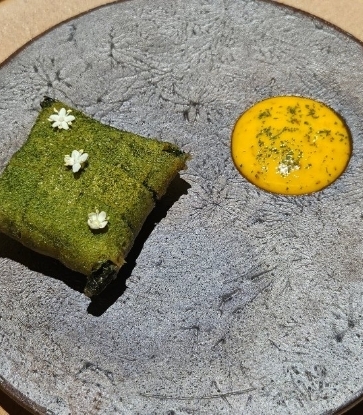In fact, it’s a timeless theme as our city has historically always been fertile ground from which home cooks and hawkers alike adapt flavours, ingredients and techniques. That’s no different for chefs today as they find inspiration everywhere from humble HDB bakeries to bell-clanging ‘ice cream uncles’.
When asked, many chefs point out that incorporating local flavours is about understanding the country’s flavour preferences.
“Each country’s palates are quite different,” says chef Steve Allen who’s worked in London, Malaysia and now helms Pollen here in Singapore. His fifth anniversary menu includes a dish that takes inspiration from bak kut teh but made with beef in a classic English way [see below]. “By taking inspiration from the humble Bak Kut Teh, we are appealing to local tastes by presenting something familiar without being too obvious.”

Agreeing, chef Aitor Orive of one-Michelin-starred Iggy’s sums it up succinctly: “The most powerful thing you can do as a chef is be able to trigger someone’s memories through a dish you present.”
We have a look at some exquisite creations across the spectrum of restaurants and eateries.

Each year, chef Andre Chiang and his team at two-Michelin-starred Restaurant Andre put their heads together to dream up a new rendition for Snickers 2.0, their iconic dessert. This year, the elements of the dish are given a heartwarming local spin by letting diners choose between having it with a wafer or on rainbow bread. If that sounds familiar, it’s because he was inspired by the ‘ice cream uncles’ lining the streets of Singapore who peddle rectangular blocks of ice cream for less than $2. The version served in the rainbow bread is especially comforting as all the elements that make up the Snickers 2.0 in all its chocolate, caramel and nutty glory is slotted in between a soft brioche-based bread.

Lei Cha Fan or Thunder Tea Rice is a traditional Hakka dish where rice is enjoyed with a medley of chopped greens and peanuts topped with a herbal green tea broth. The dish originates from the Hakka community way back in China’s Three Kingdoms and was brought to Singapore by way of Hakka immigrants. At SPRMRKT, it’s given a Western spin as the rice is replaced by risotto cooked in a green tea and vegetable broth while the greens come in the form of lady’s finger and asparagus tempura accompanied by grilled corn, dehydrated enoki mushrooms and crispy white bait.

Kaya is a national favourite for good reason and pastry chefs like to tinker around with the flavours too. Tarte by Cheryl Koh has a pandan coconut tart inspired by old school kaya tarts that come with a buttery flakey pastry. “It consists of a coconut frangipane baked into a tattle, and filled with a pandan coconut flavoured curd,” says chef Cheryl Koh. “The pandan curd and coconut frangipane uses french pastry techniques and represents both Tarte (french style pastries) and Singapore.

The name ‘Low Country Laksa’ on the menu might prompt some head scratching at first but it’s really an amalgamation of Carolina rice pirlau – a South Carolina low country rice stew with the local favourite. Here, Carolina Gold rice meets the hearty goodness of laksa gravy. “The sauce for our Laksa dish is very similar to the traditional Singaporean recipe, using laksa leaves, caramelised ginger, shallots and coconut milk,” says John Kunkel. “The flavours of our Laksa dish make us feel like we’re at home with family and friends.”

Sambal stingray – or barbecued stingray lathered with sambal served on a banana leaf – is one of those fixtures of popular hawker centres from Newton Food Centre to Chomp Chomp in Serangoon Garden. Indeed, it’s in the latter that chef Aitor Orive found inspiration from and conceived a two-part taco dish, one of which is essentially, a slice of sambal stingray made in-house. This sits on a green flatbread meant to symbolise the banana leaf.
“I’ve always wanted to do a taco dish for the menu, and had a flashback about this sambal stingray,” he says. “I thought that the components of a taco and sambal stingray had a lot of similarities—there’s always protein, there’s something spicy, there’s citrus and plenty of fresh herbs.”

Ever wished you could combine the coconut lusciousness of chendol with the multi-flavoured sweetness of ice kachang? At Botanico, you could, albeit in a modern interpretation. The team here has created a parfait of frozen gula melaka palm sugar mousse with coconut foam reminiscent of chendol and paired it with a salted corn sorbet and rose meringue shards – flavours enjoyed in ice kachang. The entire creation sits on a bed of gula melaka crumble for a bit of crunch.

Chef Steve Allen’s stint in Malaysia sees him regularly visiting Singapore and he’s had the chance to sample both versions of bak kut teh before dreaming up his own that merges both the peppery and the herbal adaptations with French and English techniques.
The result? An English boiled beef dish in a French consommé infused with Chinese herbs. “The dish has the spices from the Malaysian version, but also the pepper and garlic from the Singaporean version. I even included a little bit of Szechuan pepper for added kick,” he explains. “It’s about taking four different cultures--French, British, Singaporean and Malaysian—and finding similarities that can form a cohesive dish that is relatable for everyone.

Suan Pan Zi, or Hakka Abacus Seeds meets Italian gnocchi at Antoinette, whose founder and chef Pang Kok Keong himself is of Hakka heritage. Here, beetroot, sweet potato and purple sweet potato is made into a bouncy gnocchi stir fried with a savoury medley of dried shrimp, foie gras, cured pork and morel.




















